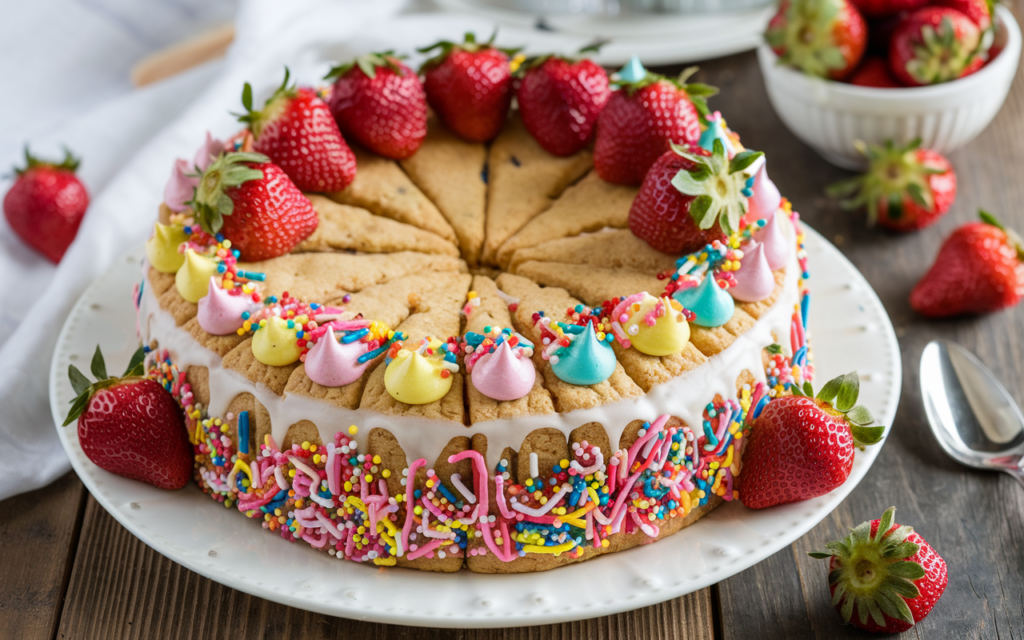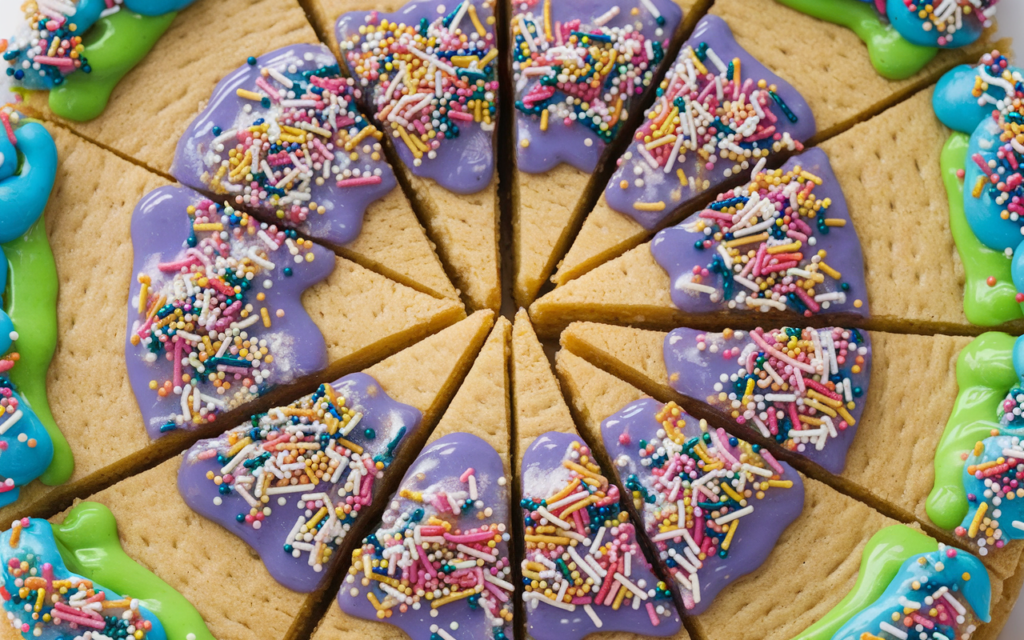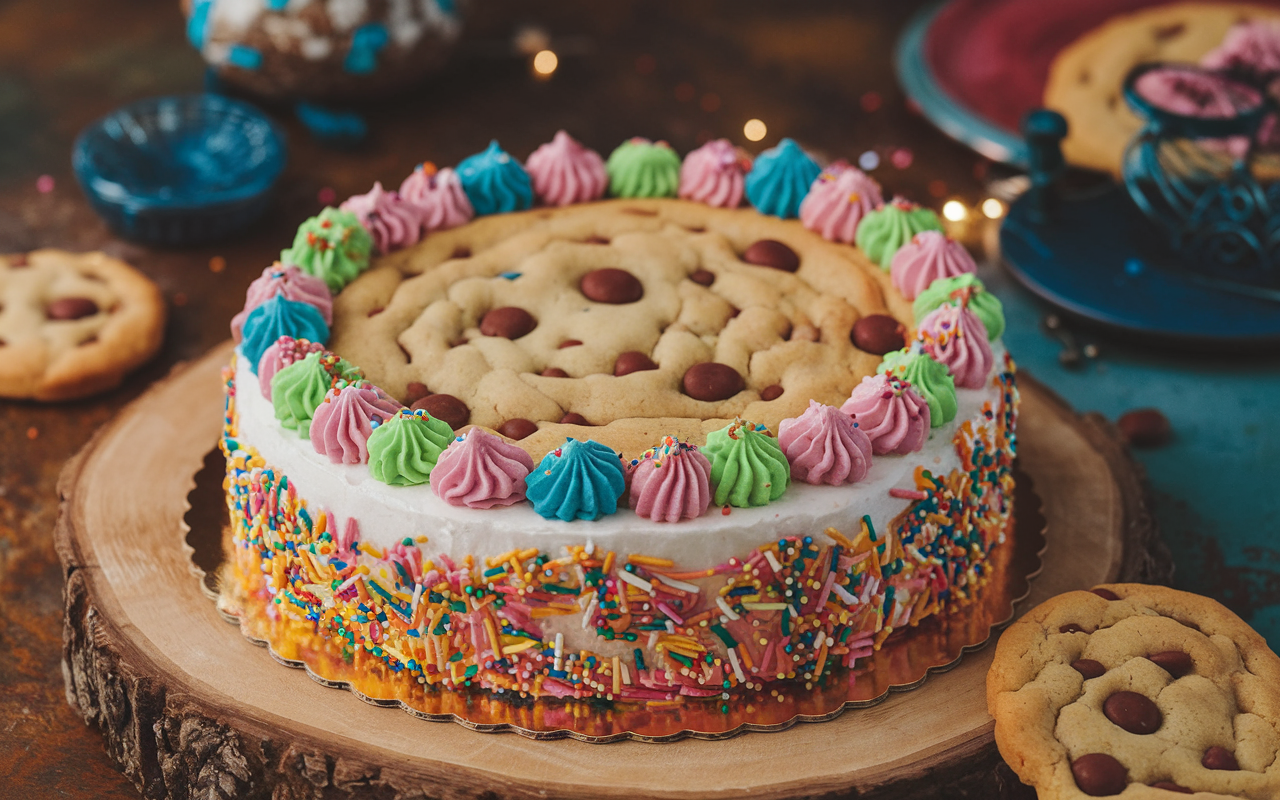cookie cakes are a fun, delicious dessert that brings together the best of both worlds: cookies and cakes. With a chewy, thick, and sweet flavor, cookie cakes are perfect for any celebration, from birthdays to holidays and everything in between. This comprehensive guide covers everything from baking the perfect cookie cake to decorating it and storing leftovers. Let’s explore all the tips, tricks, and techniques to help you make the most mouthwatering cookie cake ever!
What Is a Cookie Cake?
A cookie cake is essentially a giant cookie, baked in the shape of a cake, often decorated with frosting or other sweet toppings. Unlike traditional cookies, which are small and crispy, the cookie cake is thick, chewy, and soft, making it a unique dessert option that appeals to cookie lovers and cake lovers alike.
Cookie cakes come in various sizes and flavors, from classic chocolate chip to funfetti, and can be customized for any occasion. They are often decorated to look like cakes, making them a perfect alternative to traditional birthday cakes.
History of Cookie Cakes
The idea of a cookie cake likely evolved as a fun, creative twist on the classic American cookie. While it’s difficult to pinpoint the exact moment when cookie cakes became popular, they gained significant attention in the 1970s and 1980s. Brands like Great American Cookie Company were instrumental in popularizing cookie cakes by offering them as a celebratory dessert for birthdays and other special occasions. Over time, cookie cakes became a staple in many bakeries and home kitchens, offering a chewy, fun alternative to regular cakes.
Why You Should Make a Cookie Cake
There are many reasons why cookie cakes are a must-try dessert. Here are a few:
- Chewy Texture: Unlike traditional cakes, cookie cakes offer a rich, chewy texture that everyone loves.
- Customizable: You can personalize your cookie cake with different toppings, mix-ins, and even the flavor of the dough.
- Easy to Decorate: Decorating a cookie cake is simple yet rewarding. You can create fun designs, write messages, or even shape it into themed cakes.
- Versatile: Cookie cakes are perfect for any occasion — birthdays, holidays, weddings, and even casual get-togethers.
- Crowd-Pleaser: Since it’s so large and easy to slice, a cookie cake is a perfect dessert for gatherings, making it easy to share with friends and family.
Ingredients for the Perfect Cookie Cake
Making the perfect cookie cake requires just a few basic ingredients. Here’s what you’ll need:
- Flour: The backbone of any cookie cake, all-purpose flour provides structure and helps the dough hold together.
- Butter: Unsalted butter works best, as it gives the cookie cake its rich flavor and a soft, chewy texture.
- Sugar: Both granulated sugar and brown sugar are important in creating a balance of sweetness and moisture.
- Eggs: Eggs are essential for binding the ingredients and helping the cookie cake rise and stay moist.
- Baking Soda: Baking soda is a leavening agent that helps the cake spread out while baking, ensuring it doesn’t become too thick.
- Vanilla Extract: Vanilla adds a depth of flavor and enhances the sweetness of the cake.
- Salt: A pinch of salt can help bring out the sweetness of the sugar and balance the overall flavor.
- Chocolate Chips (optional): For chocolate chip cookie cakes, add semisweet or milk chocolate chips to the dough for extra indulgence.
Optional Add-Ins
While classic chocolate chip is a popular choice, you can customize your cookie cake with various add-ins. Some of the best options include:
- M&Ms: Colorful and fun, M&Ms add a pop of color and a candy crunch.
- Nuts: Chopped nuts like walnuts or pecans add texture and a nutty flavor.
- Candy Pieces: Broken-up candy bars or caramel bits can add a new level of sweetness and chewiness.
- Fruit: Dried fruits like cranberries, raisins, or even fresh blueberries can be mixed in for a fruity twist.

How to Make a Cookie Cake
Baking the perfect cookie cake is simple if you follow the right steps. Here’s an easy-to-follow recipe that guarantees great results every time.
Ingredients
- To make a mouthwatering cookie cake, you’ll need the following ingredients:
- 2 1/4 cups all-purpose flour – This is the main structure of your cake, ensuring it holds together.
- 1 cup unsalted butter, softened – Softened butter is crucial for achieving the right texture in your cookie cake.
- 1/2 cup granulated sugar – Granulated sugar adds the sweetness and helps achieve a crisp edge.
- 1 cup packed brown sugar – Brown sugar enhances the cake’s moisture, making it soft and chewy.
- 2 teaspoons vanilla extract – Vanilla extract brings a deep, aromatic flavor to the dough.
- 2 large eggs – Eggs provide structure and moisture, ensuring the dough holds together and rises properly.
- 1 teaspoon baking soda – This helps the cake rise, giving it that perfect chewy texture.
- 1/2 teaspoon salt – Salt enhances the sweetness and balances the flavors.
- 2 cups chocolate chips (optional) – If you’re making a chocolate chip cookie cake, these are a must for that delicious chocolatey finish.
- By carefully combining these ingredients, you can bake a soft, chewy, and perfectly flavored cookie cake. Each ingredient plays a role in creating the ideal texture and flavor.
Instructions
- Preheat the Oven: Preheat your oven to 350°F (175°C). Grease a 9-inch round cake pan or line it with parchment paper for easy removal.
- Mix the Wet Ingredients: In a large mixing bowl, cream the softened butter, granulated sugar, and brown sugar together until fluffy. This should take about 2-3 minutes. Add in the eggs one at a time, beating well after each addition. Stir in the vanilla extract.
- Combine the Dry Ingredients: In a separate bowl, whisk together the flour, baking soda, and salt. Gradually add the dry ingredients to the wet ingredients, mixing until just combined. Be careful not to overmix.
- Add Chocolate Chips and Mix-ins: Fold in the chocolate chips (or other mix-ins). If you’re using a combination of different mix-ins, feel free to get creative with flavors!
- Bake the Cake: Spread the dough evenly in the prepared pan. Bake for 20-25 minutes or until the edges are golden brown, and the center is set but still slightly soft. Keep an eye on the cake during the last few minutes of baking to prevent it from overcooking.
- Cool and Decorate: Once the cookie cake is done, remove it from the oven and let it cool in the pan for 10-15 minutes before transferring it to a wire rack. Let it cool completely before decorating with frosting and other toppings.
Decorating Your Cookie Cake
Decorating a cookie cake is an opportunity to get creative and personalize it for any occasion. Here are some decorating ideas:
Icing and Frosting
- Buttercream Frosting: Buttercream frosting is one of the most popular options for cookie cakes. It’s easy to make, and, in addition, it can be tinted any color you prefer. You can either use a piping bag to create intricate designs, or alternatively, you can spread a thick, even layer of frosting over the top for a simple yet delicious finish.
- Royal Icing: If you’re looking for a smooth, glossy finish, royal icing is an excellent choice. As it dries, royal icing hardens, making it ideal for detailed decorations and personalized messages. Moreover, it provides a clean, polished look to your cookie cake.
- Chocolate Ganache: For those who prefer a rich, decadent touch, drizzling a chocolate ganache over the top of your cookie cake is the way to go. Not only does it add a luxurious texture, but it also pairs perfectly with flavors like chocolate chip or peanut butter cookie cakes. In addition, the glossy finish of ganache makes the cookie cake look irresistibly delicious.
Fun Toppings
- Sprinkles: Add colorful sprinkles for a festive touch. This is especially great for birthdays or holidays.
- Candy: Top the cake with candy like gummy bears, M&Ms, or chocolate bars.
- Fresh Fruits: Add some sliced strawberries, raspberries, or blueberries for a fresh and vibrant finish.
Best Pans for Baking Cookie Cakes
The pan you use can make a big difference in the texture and appearance of your cookie cake. Here are some great options:
- Round Cake Pan: A standard 9-inch round cake pan works perfectly for a classic cookie cake.
- Square or Rectangular Pan: If you want a cookie cake with more slices or a different shape, a square or rectangular pan is ideal.
- Cast-Iron Skillet: For a rustic, chewy texture, bake your cookie cake in a cast-iron skillet. It gives the cake a crispy edge while keeping the center soft.
How to Store Cookie Cakes
After baking and decorating your cookie cake, you may have some leftovers. Here’s how to store them properly:
- Room Temperature: If you plan to eat your cookie cake within 2-3 days, store it at room temperature in an airtight container.
- Refrigeration: For longer storage, wrap the cookie cake tightly in plastic wrap and store it in the fridge. Refrigerating the cookie cake can extend its freshness by a few extra days.
- Freezing: If you have a large cookie cake and want to save some for later, freezing is an excellent option. Wrap the cake tightly in plastic wrap and aluminum foil, then freeze it for up to three months. To enjoy later, let it thaw at room temperature for a few hours.
Troubleshooting Common Cookie Cake Issues
Even the best bakers sometimes run into a few challenges when making a cookie cake. Here are some common problems and solutions:
- Cookie Cake Too Thick: If your cookie cake is too thick, it may not bake evenly. Use a slightly larger pan, or reduce the amount of dough.
- Cookie Cake Too Dry: Overbaking is a common culprit for a dry cookie cake. Check the cake a few minutes before the recommended baking time to ensure it’s just baked through but not overdone.
- Cookie Cake Won’t Come Out of the Pan: To prevent sticking, line the pan with parchment paper or grease it well. If using a cast-iron skillet, make sure it’s seasoned properly.
1. How to Make Cookie Cake in Different Flavors
Cookie cakes can be made in a variety of flavors, offering something for every palate. The classic chocolate chip is just the beginning — here are some exciting options to try:
- Peanut Butter Cookie Cake: Swap out some of the butter for peanut butter to create a rich, nutty flavor. You can even add chocolate chips or peanut butter cups for extra texture.
- Funfetti Cookie Cake: This fun, colorful version is perfect for birthdays or celebrations. Add sprinkles directly into the dough for a vibrant, festive treat.
- Double Chocolate Cookie Cake: Add cocoa powder to the dough to create a rich chocolatey base, and use chocolate chips for an extra indulgent dessert.
- Cinnamon Roll Cookie Cake: Combine the flavors of a cinnamon roll with your cookie cake. Use cinnamon in the dough and top it with a simple glaze for a sweet twist.
Internal Link: You can refer your readers to other cookie recipes on your site, such as Cookie Recipes for Every Occasion.
2. Cookie Cake vs. Traditional Cake: What’s the Difference?
Understanding the difference between a cookie cake and a traditional cake can help you decide when to serve each. Here’s a breakdown of the main differences:
- Texture: Cookie cakes are chewy and thick, while traditional cakes are light and fluffy.
- Preparation: Cookie cakes require fewer ingredients and less time to bake than traditional cakes.
- Taste: Cookie cakes tend to have a more concentrated flavor, with the richness of butter and brown sugar coming through.
For more insights into baking different types of cakes, check out Cake Baking Tips and Tricks.
3. Creative Decorating Ideas for Cookie Cakes
Cookie cakes are blank canvases for creativity. Here are some unique decoration ideas to take your cookie cake to the next level:
- Photo Cake: Use edible photo paper to create a personalized cake design, perfect for birthdays or special events.
- Whipped Cream Toppings: Light, fluffy whipped cream is a great alternative to frosting, especially for summer gatherings.
- Fruit and Nut Combos: Fresh fruits like strawberries and blueberries, combined with nuts such as pistachios or almonds, make for an elegant topping.
Check out this Creative Cake Decorating Guide for more ideas.
4. How to Adjust Your Cookie Cake Recipe for Dietary Needs
Cookie cakes are easy to adjust for various dietary preferences. Here’s how to make a cookie cake that meets everyone’s needs:
- Vegan: Swap butter for vegan margarine and use flaxseed or chia seeds as an egg replacement.
- Gluten-Free: Use a gluten-free flour blend and ensure your baking powder is gluten-free.
- Low Sugar: Replace the sugar with a sugar substitute like stevia or monk fruit to reduce the sweetness without sacrificing flavor.
If you’re interested in more dietary-friendly recipes, visit
5. Troubleshooting Cookie Cake Problems
Baking a cookie cake is fun, but there are some common issues that can arise. Here’s how to troubleshoot:
- Overbaking: If the edges are hard but the center is undercooked, you’ve probably overbaked it. Reduce the baking time slightly next time.
- Cake Sticking to the Pan: Always grease the pan thoroughly or use parchment paper to ensure easy removal.
- Cake Too Thick: If the cake is too thick, flatten the dough out before baking or use a larger pan for a thinner result.
For more baking tips, see How to Perfect Your Cookie Baking Skills.

Frequently Asked Questions (FAQs)
How Much Should a Cookie Cake Cost?
Cookie cakes can vary in price depending on size, ingredients, and decoration. On average, a simple 9-inch cookie cake from a bakery might cost between $20 and $40. Custom or premium versions with additional decorations or fillings may cost more.
Can You Make a Cookie Cake Ahead of Time?
Yes, you can make a cookie cake ahead of time. It can be baked up to 2 days in advance and stored at room temperature. If you want to decorate it later, wait until the cake is completely cooled before adding the frosting or decorations.
Can You Use Gluten-Free Flour for Cookie Cakes?
Yes! If you need a gluten-free option, you can easily substitute all-purpose flour with a gluten-free flour blend. However, it’s important to follow specific guidelines for gluten-free baking, as the texture may differ slightly from traditional cookie cakes. For example, you may need to adjust the baking time or add a bit more moisture to the dough. Additionally, some gluten-free flour blends include xanthan gum, which helps with the structure and texture of the cake, so be sure to check if your blend contains it. By making these adjustments, you can create a delicious, gluten-free cookie cake that’s just as satisfying as the classic version.
Conclusion
Cookie cakes are a delightful dessert that combines the comforting chewiness of a cookie with the celebratory look of a cake. Whether you’re baking for a birthday, a holiday, or just because, cookie cakes are a fun, easy, and customizable option that can please any crowd. With the tips and ideas shared in this guide, you can confidently create the perfect cookie cake every time. From experimenting with different flavors to troubleshooting common baking problems, you now have all the tools you need to bake your own delicious cookie cake. So, grab your ingredients, preheat the oven, and get baking — your ultimate cookie cake awaits!

